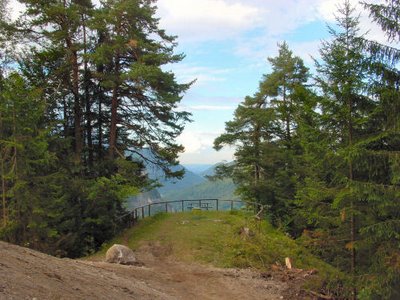Oberau And The Obersalzburg
Having decided early in 2006 that it would be the year of mountains for me, I journeyed to the continental divide in both the eastern and western United States. The Blue Ridge mountains are beautiful for sure, and the Rockies awe inspiring. But neither are as dramatic as the German Alps. And once they stood before me in majestic splendor, I knew that I had saved the best for last.
My hotel was the Alpenhotel Denninglehen, a mountain chalet above the village of Oberau with an indoor pool, a sauna room, massage service and a scenic restaurant where breakfast and dinner were served daily. After traveling most of 5000 miles, the remote solitude of this setting provided a welcome respite from the hustle and bustle that brought me there. From the balcony of my room, I could see a building not far away that was situated on the edge of a cliff. It appeared to be at the top of the world. Almost immediately, I recognized it as being the Kehlsteinhaus. The dome of a cathedral graced the valley below me. A deer grazed in the morning mist while an owl preened in a nearby tree. To the east, the Austrian border was only minutes away. Looking north, the Untersburg mountain towered above Salzburg. In the westerly direction, there was a mountain called the Obersalzburg.







One of the more recent historical events that took place in this area was when the Nazis took over the Obersalzburg and made it Hitler's second seat of power. This mountain was within walking distance, so I hiked over and took some pictures.
On the way up the mountain was a speed limit sign that included a speed limit for tanks.

This is the foundation of a cottage in the woods that came to be known as Kampfhausl. When Hitler was released from prison, he retreated here and finished the second part of Mein Kampf .

In what was the corner of the Kampfhausl, someone had placed a candle, apparently as a shrine to Hitler.

Likewise, the foundation is all that's left of the elaborate guardhouse at the entrance to Hitler's compound.

The upper driveway that led to the side of Hitler's residence, which he named the Berghof.

The Berghof was heavily damaged by British bombers in 1945 at the close of the war. Later, the ruins were buried and trees have been planted to try and reforest the site of Hitler's house. The ground level as seen in this photo is several feet higher than it was during the war. All that remains are parts of the foundation and a bunker system that has been sealed off.


Within view of the Berghof site is the Zum Turken Hotel. It was taken over by the Nazis and used to house Hitler's bodyguards. It too was heavily damaged at the end of the war, but the daughter of the former owner eventually regained ownership and rebuilt it. The hotel is still open to the public.

In this view of the Turken, you can see the small guard post that was built in front by the Nazis.

When the tide of war began to turn against the Axis powers, elaborate bunkers were constructed under the Obersalzburg. The most interesting one to me was accessible through the Turken. The bunker is entered by a long series of circular stairs with rooms extending off to the side. Further down, there are corridors leading to various places. At the end of a long stairway, you are greeted by a machine gun stand.

One of the places this corridor led to was separate underground rooms built for Hitler, Eva Braun and Hitler's doctor. These rooms have been sealed off to the public.

Up the hill from the Turken was the area where the SS barracks and the kindergarten buildings were located. The foundations of these ruins were removed just a few years ago. The area is now a parking lot for those who wish to explore the area. In the warmer months, tourists can take a shuttle from here to the Hintereck parking lot and then ride an elevator up to the Kelsteinhaus (Eagle's Nest), which is now a restaurant.

One of the few remaining buildings of the Obersalzburg complex. It was a large terrace hall that was originally part of the Platterhof hotel. Under the American occupation, the building was called the "Skyline Room". The hall now houses a restaurant where patrons can either dine inside or out on the terrace.

The Intercontinental Hotel, now known as the Kempinski Hotel, was built on the site where Herman Goering lived. It is a luxury hotel that was far too expensive for my budget. There was some controversy regarding the building of this hotel between those who seek to preserve the history of this site and others who would prefer that the Obersalzburg not be forever associated with the Nazis.

This is the former location of Hitler's Teehaus. The fresh pile of dirt in the foreground is where the Teehaus once stood. It was partly destroyed back in the 50's and the ruins were buried just two weeks before I took this picture.

The famous overlook at the Teehaus. The eastern edge of the Untersberg can be seen on the left and the city of Salzburg lies beyond it in the distance.

This building was rebuilt and now houses a Documentation Center about the Third Reich. The tour includes a walk through a different bunker from the one under the Turken Hotel.


































